Sushi (寿司 or 鮨 or 鮓) is much appreciated for its delicate taste and exquisite appearance. Sushi actually means vinegared rice, which is the essential ingredient in every sushi recipe. Sushi is simple and cheap to make at home, needs no special equipment and is an excellent way to use left overs. Although sushi in various forms has been around for fourteen centuries, the modern version was invented in Japan in the 1800's where a 'hand-formed' sliced fresh fish and vinegared rice ball was eaten as a snack food. Nowadays, sushi is made with various seafood, meats and vegetables, raw and cooked.
I love sushi. It's the first food I'm thinking about when we are going to Dresden at the weekends. There is no place you can get good sushi here, so I always have a crave for it when there is a possibility to get some. But making it yourself is something completely different. First of all I had again problems getting hold of certain ingredients - no chance of getting sushi grade fish ... I used smoked one and liked the taste even better. I never thought the rice would be the most labour-intensive part of the work, but it was. Doing the caterpillar roll was even more tricky - sticky rice all over the place, no knife which was sharp enough to cut sufficiently which resulted in a really squeezed appearance. I liked the avocado topping though I normally wouldn't eat it. In the end we had good homemade sushi (exept for some disfigurements) and Robert already dreamed of inviting our friends for dinner ... (No way, how am I gona produce that amount of sushi rice?)
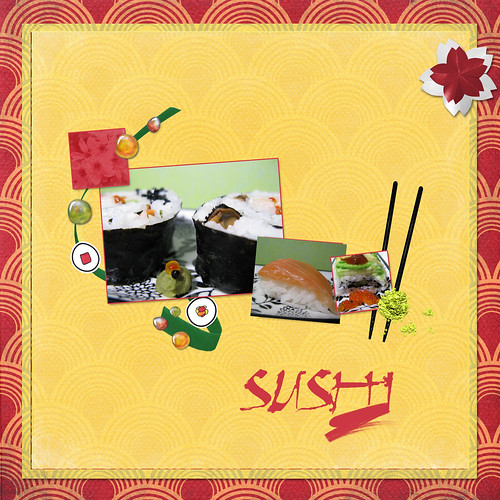 SUSHI RICE
(makes about 7 cups of cooked sushi rice)
Preparation time:
SUSHI RICE
(makes about 7 cups of cooked sushi rice)
Preparation time: 1¾ hours consisting of :
Rinsing and draining rice: 35 minutes
Soaking rice: 30 minutes (includes 5 minutes making the vinegar dressing)
Cooking and steaming time: 25 minutes
Finishing the rice: 15 minutes
- 2½ cups uncooked short grain rice
- 2½ cups water
Sushi vinegar dressing
- 5 Tablespoons (75 mls) rice vinegar
- 5 Teaspoons (25 mls or 21 grams) sugar
- 1¼ Teaspoons (6.25 mls or 4.5 grams) salt
Swirl rice gently in a bowl of water, drain, repeat 3-4 times until water is nearly clear. Don't crush the rice in your hands or against the side of the bowl since dry rice is very brittle. Gently place rice into a strainer and drain well for 30 minutes. Place the rice into a heavy medium pot with a tight fitting lid (if you have a loose fitting lid use a piece of aluminium foil to make the seal tight). Set the rice aside to soak for 30 minutes, during this time prepare the sushi rice dressing.
Combine the rice vinegar, sugar and salt in a small bowl. Heat on low setting. Stir until the mixture goes clear and the sugar and salt have dissolved. Set aside at room temperature until the rice is cooked.
After 30 minutes of soaking add sake (if using) to the rice. Bring rinsed and soaked rice to the boil. Reduce heat to the lowest setting and simmer, covered, until all the water is absorbed, 12-15 minutes. Do not remove the lid during this process. Turn off heat. Let stand with the lid on, 10-15 minutes. Do not peek inside the pot or remove the lid. During this time the rice is steaming which completes the cooking process.
Moisten lightly a flat thin wooden spatula or spoon and a large shallow flat-bottomed non-metallic (plastic, glass or wood) bowl. Do not use metallic objects since the vinegar will react with it and produce sour and bitter sushi rice. Use the spatula to loosen gently the rice and invert the rice pot over the bowl, gently causing the cooked rice to fall into the bowl in one central heap. Do this gently so as not to cause the rice grains to become damaged. Slowly pour the cooled sushi vinegar over the spatula onto the hot rice. Using the spatula gently spread the rice into a thin, even layer using a 45° cutting action to break up any lumps and to separate the rice. Don't stir or mash rice. After the rice is spread out, start turning it over gently, in small portions, using a cutting action, allowing steam to escape, for about a minute.
Continue turning over the rice, but now start fanning (using a piece of stiff cardboard) the rice vigorously as you do so. Don't flip the rice into the air but continue to gently slice, lift and turn the rice occasionally, for 10 minutes. Cooling the rice using a fan gives good flavour, texture and a high-gloss sheen to the rice. The vinegar dressing will be absorbed by the hot rice. Using a small electric fan on the lowest speed setting is highly recommended. Stop fanning when there's no more visible steam, and all the vinegar dressing has been adsorbed and the rice is shiny. Your sushi rice is ready to be used. Cover with a damp, lint free cloth to prevent the rice from drying out while preparing your sushi meal. Do not store sushi rice in the refrigerator leave on the counter covered at room temperature. Sushi rice is best used when it is at room temperature.
Tip: To make sushi rice: for each cup of rice use 1 cup of water, 2 Tbs rice vinegar, 2 tsp sugar, ½ tsp salt and 1 tsp sake. For superior results use equal volumes of rice and water when cooking the sushi rice since the weight of rice can vary. Weight of 2½ cups of uncooked rice is about 525 grams or 18½ ounces.
DRAGON ROLLS (also called Caterpillar Rolls)
Yield: 2 inside-out (uramaki) sushi rolls
 1 sheet 7"x8" (17.5cmx20cm) of toasted nori (dried seaweed sheets), cut into halves
1 sheet 7"x8" (17.5cmx20cm) of toasted nori (dried seaweed sheets), cut into halves- 1/2 (Japanese) cucumber
- 2 cups of prepared sushi rice
- smoked salmon (about 3½ ounces or 100 grams)
- 1 Avocado
- Vinegared Water - ½ cup of water combined with a dash of rice vinegar
- Various small amounts of sauces to use as the flames of the dragon (or legs of a caterpillar)
- 2 tablespoons (25 grams or 1 oz) Fish Roe (Fish eggs) (optional)
Cut cucumber into strips ¼ inch (6mm) x 7" (175mm) long, then salt, rinse & dry the strips. Cut salmon into two lengthwise strips. Halve, pit and peel the avocado. Cut the avocado halves into thin even 1/8 inch (3 mm) slices. Fan out the cut avocado into a 7 inch (175 mm) overlapping pattern. Cover bamboo mat with plastic wrap. Place a sheet of nori shiny side down , lengthwise, on the edge the mat. Moisten lightly your hands in the bowl of vinegared water. Place one cup of rice on the nori and gently rake your fingertips across grains to spread rice evenly. Do not mash or squash the rice onto the nori, the rice should appear loosely packed and be evenly distributed over the entire sheet, you should be able to see the nori sheet in a few places. Flip the rice-covered nori over (so the bare nori is now on top) and place on the edge of the mat closest to you. Arrange one of the eel strips across the length of the nori, not quite centred on it but a little closer to you. Place half the cucumber sticks next to the eel. Lift the edge of the mat closest to you with both hands, keeping your fingertips over the fillings, and roll the mat and its contents until the edge of the mat touches straight down on the nori, enclosing the fillings completely. Lift up the edge of the mat you're holding, and continue rolling the inside-out roll away from you until it's sealed. Tug at the mat to tighten the seal. If the rice doesn't quite close the roll add more rice in the gap and re-roll using the mat to completely cover the inside-out roll. Place the roll on a damp, clean smooth surface. Spread about 1 tablespoon of the optional fish roe along the entire top of the rice-covered roll. Using the plastic covered mat gently press the fish roe so it adheres to the rice. Slide a knife under one fan of avocado and transfer it onto the top of an inside-out roll. Gently spread out the avocado layer to cover the entire roll. Lay the plastic wrapped mat over the avocado-covered roll. Squeeze very gently to shape the roll. Lay a sheet of plastic wrap over the roll. Slice the roll into 6-8 equal, bite-sized pieces, wiping your knife with a damp towel before each slice. Discard the plastic wrap. Repeat the above to make one more roll. Arrange the cut pieces on a serving plate with the sauces so the finished dish appears as a dragon breathing fire and flames (or a caterpillar with many legs).
The most common mistake is having too much filling the golden rule is less is more when it comes to making sushi it is easier to roll an under-filled roll than an over-filled roll. Dampen your knife with a moist lint-free towel before every cut - this prevents the sushi rice from sticking to your knife.
Excellent video on making Dragon Rolls.
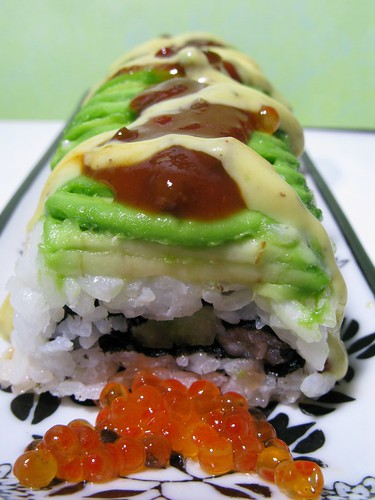 SPIRAL SUSHI ROLL
Yield: One Roll, cut into 8 pieces
SPIRAL SUSHI ROLL
Yield: One Roll, cut into 8 pieces
- 2½ cups prepared sushi rice
- 2 sheets of toasted nori, each sized 7"x8" (17.5cmx20cm)
- Six assorted fillings, each filling should be the size of a pencil,
- my choices: salmon, fish roe, vegetarian fish roe (contains seaweed), shitake mushrooms, cucumber, blue mussels
Join 2 sheets of nori by moistening the adjacent edges and overlapping them about ½ inch (12mm). Place this double
sheet shiny side down on a rolling mat, part of the nori will extend beyond the mat. Using moist fingers place 2½ cups of rice on the nori and gently rake your fingertips across grains to spread rice evenly, leaving ¼ inch (6mm) nori showing on the both ends of the sheet. Do not mash or squash the rice onto the nori, the rice should appear loosely packed and be evenly distributed over the entire sheet,
you should be able to see the nori sheet in a few places. Using your fingers form six grooves (in the same direction that you will be rolling the mat) at even intervals across the bed of rice. Make each groove about a finger-width wide they will hold about 1-2 tablespoons of filling. Make the first groove about 2 inches (50 mm) from the edge of the nori sheet. Form the grooves by pushing the rice away, do not mash or squash the rice, leave a loose one grain layer of rice in the bottom of the grooves. Level the areas between the grooves where you have pushed the rice. Place your fillings in the grooves. Fill the grooves a little higher than the surrounding rice bed. Then roll the sushi up from the edge closest to you, this will form a spiral pattern of nori, rice and fillings inside the roll. Slice into 8 pieces with a very sharp wet knife,
wiping the blade with a damp cloth after each cut. Place the pieces on a platter and garnish.
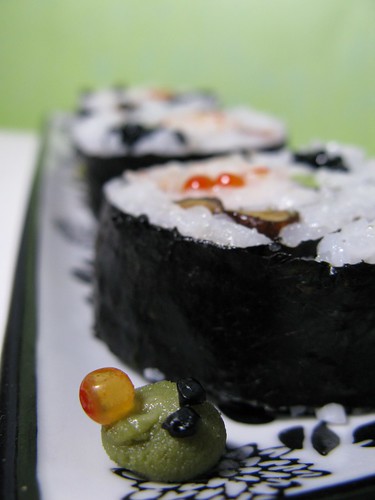
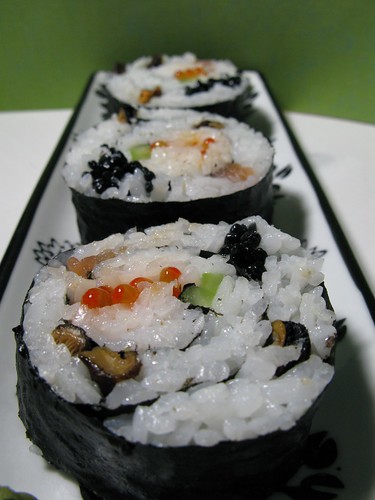
Nigiri sushi is the type of sushi most often made in sushi bars. In Japanese, nigiri means "squeeze".
- 2 cups prepared sushi rice
- 8 pairs of assorted toppings, 200 gms/7 ozs total of fish, meat or vegetables (see note below)
- 1 tablespoon Wasabi (paste, reconstituted powder) or any other paste to adhere topping to rice
When handling sushi rice, make certain your hands are very clean. To keep the rice from sticking to our hands moisten your hands with vinegared water. Form nigiri sushi by scooping up a small amount (about 2 tablespoons) of rice with your forefinger and second finger of your right hand and placing it in your cupped left palm. Use the fingers and thumb of your right hand to form it into a long, narrow mound (about 2 inches x 1 inch wide or 50mm x 25mm) in your cupped palm. Press enough to make the rice hold firmly together. Place the nigiri on a damp cutting board flat side down. Don't let sushi touch or they'll stick to each other. At this point, you can cover the sushi with plastic wrap, and they'll keep at room temperature (not the refrigerator) for several hours. Smear a thin line of wasabi on top of the rice and place the topping piece on it. You may need to press the topping down lightly with your fingers and adjust the shape of the rice accordingly to form an attractive piece of nigiri sushi. If your topping is very loose like fish roe you can place a strip of nori (higher than the rice) around the nigiri and form 'battleship' sushi. The cavity that the nori forms holds the topping so it does not fall off. Garnish as desired and use strips of nori (or vegetable) to tie the topping to the nigiri if needed.
A great video on making nigiri sushi.
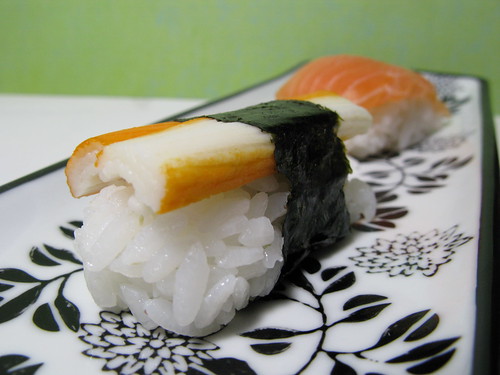

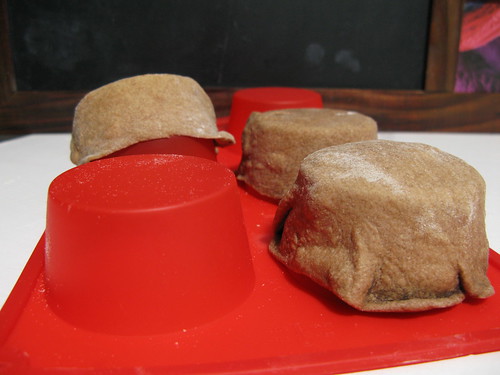



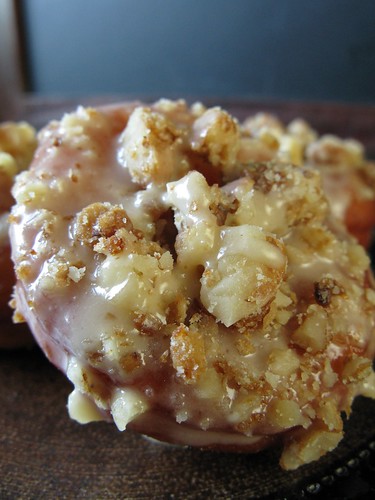 Für die "Streusel" die Walnüsse in einer Pfanne anrösten. Den Sirup dazugeben und gut verteilen. Bei mittlerer Hitze karamellisieren lassen bis alles von den Nüssen 'aufgesogen' ist. Auf einem mit Backpapier ausgelegtem Blech verteilen und erkalten lassen. Mit Hilfe einer Pfanne oder Nudelholzes in kleine Stücke hacken. Den Puderzucker portionsweise mit dem Ahornsirup mischen bis die Glasur eine dickflüssige Konsistenz hat. Dann auf den Donuts verteilen und mit den "Streuseln" bestreuen.
Für die "Streusel" die Walnüsse in einer Pfanne anrösten. Den Sirup dazugeben und gut verteilen. Bei mittlerer Hitze karamellisieren lassen bis alles von den Nüssen 'aufgesogen' ist. Auf einem mit Backpapier ausgelegtem Blech verteilen und erkalten lassen. Mit Hilfe einer Pfanne oder Nudelholzes in kleine Stücke hacken. Den Puderzucker portionsweise mit dem Ahornsirup mischen bis die Glasur eine dickflüssige Konsistenz hat. Dann auf den Donuts verteilen und mit den "Streuseln" bestreuen.

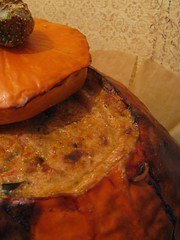


 1 sheet 7"x8" (17.5cmx20cm) of toasted nori (dried seaweed sheets), cut into halves
1 sheet 7"x8" (17.5cmx20cm) of toasted nori (dried seaweed sheets), cut into halves



